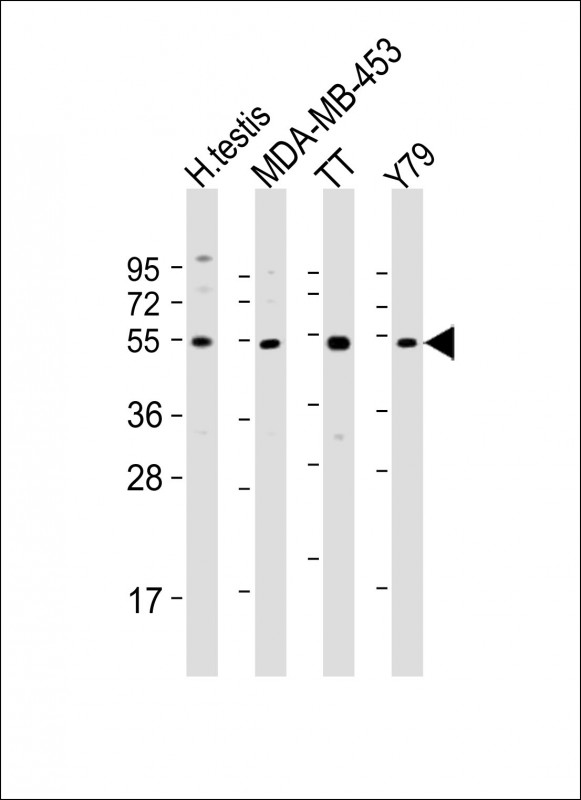WDR51B Antibody (C-term)
Purified Rabbit Polyclonal Antibody (Pab)
- SPECIFICATION
- CITATIONS
- PROTOCOLS
- BACKGROUND

Application
| WB, E |
|---|---|
| Primary Accession | Q8TC44 |
| Reactivity | Human |
| Host | Rabbit |
| Clonality | polyclonal |
| Isotype | Rabbit IgG |
| Calculated MW | 53668 Da |
| Gene ID | 282809 |
|---|---|
| Other Names | POC1 centriolar protein homolog B, Pix1, Proteome of centriole protein 1B, WD repeat-containing protein 51B, POC1B, WDR51B |
| Target/Specificity | This WDR51B antibody is generated from a rabbit immunized with a KLH conjugated synthetic peptide between 386-417 amino acids from the C-terminal region of human WDR51B. |
| Dilution | WB~~1:2000 E~~Use at an assay dependent concentration. |
| Format | Purified polyclonal antibody supplied in PBS with 0.09% (W/V) sodium azide. This antibody is purified through a protein A column, followed by peptide affinity purification. |
| Storage | Maintain refrigerated at 2-8°C for up to 2 weeks. For long term storage store at -20°C in small aliquots to prevent freeze-thaw cycles. |
| Precautions | WDR51B Antibody (C-term) is for research use only and not for use in diagnostic or therapeutic procedures. |
| Name | POC1B (HGNC:30836) |
|---|---|
| Synonyms | WDR51B |
| Function | Plays an important role in centriole assembly and/or stability and ciliogenesis (PubMed:20008567, PubMed:32060285). Involved in early steps of centriole duplication, as well as in the later steps of centriole length control (PubMed:19109428). Acts in concert with POC1A to ensure centriole integrity and proper mitotic spindle formation (PubMed:32060285). Required for primary cilia formation, ciliary length and also cell proliferation (PubMed:23015594). Required for retinal integrity (PubMed:25044745). Acts as a positive regulator of centriole elongation (PubMed:37934472). |
| Cellular Location | Cytoplasm, cytoskeleton, microtubule organizing center, centrosome. Cytoplasm, cytoskeleton, microtubule organizing center, centrosome, centriole. Cytoplasm, cytoskeleton, cilium basal body Cytoplasm, cytoskeleton, spindle pole. Note=Component of both mother and daughter centrioles (PubMed:32060285). Localizes to the basal body and centriole adjacent to the connecting cilium of photoreceptors and in synapses of the outer plexiform layer. Localizes to the inner scaffold in the central region of centrioles {ECO:0000250|UniProtKB:Q8BHD1, ECO:0000269|PubMed:32060285, ECO:0000269|PubMed:37934472} |
| Tissue Location | Expressed in the retina. |

Thousands of laboratories across the world have published research that depended on the performance of antibodies from Abcepta to advance their research. Check out links to articles that cite our products in major peer-reviewed journals, organized by research category.
info@abcepta.com, and receive a free "I Love Antibodies" mug.
Provided below are standard protocols that you may find useful for product applications.
Background
Plays an important role in centriole assembly and/or stability and ciliogenesis (PubMed:20008567). Involved in early steps of centriole duplication, as well as in the later steps of centriole length control (PubMed:19109428). Acts in concert with POC1A to ensure centriole integrity and proper mitotic spindle formation. Required for primary cilia formation, ciliary length and also cell proliferation (PubMed:23015594). Required for retinal integrity (PubMed:25044745).
References
Ota T.,et al.Nat. Genet. 36:40-45(2004).
Scherer S.E.,et al.Nature 440:346-351(2006).
Mural R.J.,et al.Submitted (JUL-2005) to the EMBL/GenBank/DDBJ databases.
Hames R.S.,et al.Exp. Cell Res. 314:574-589(2008).
Dephoure N.,et al.Proc. Natl. Acad. Sci. U.S.A. 105:10762-10767(2008).
If you have used an Abcepta product and would like to share how it has performed, please click on the "Submit Review" button and provide the requested information. Our staff will examine and post your review and contact you if needed.
If you have any additional inquiries please email technical services at tech@abcepta.com.













 Foundational characteristics of cancer include proliferation, angiogenesis, migration, evasion of apoptosis, and cellular immortality. Find key markers for these cellular processes and antibodies to detect them.
Foundational characteristics of cancer include proliferation, angiogenesis, migration, evasion of apoptosis, and cellular immortality. Find key markers for these cellular processes and antibodies to detect them. The SUMOplot™ Analysis Program predicts and scores sumoylation sites in your protein. SUMOylation is a post-translational modification involved in various cellular processes, such as nuclear-cytosolic transport, transcriptional regulation, apoptosis, protein stability, response to stress, and progression through the cell cycle.
The SUMOplot™ Analysis Program predicts and scores sumoylation sites in your protein. SUMOylation is a post-translational modification involved in various cellular processes, such as nuclear-cytosolic transport, transcriptional regulation, apoptosis, protein stability, response to stress, and progression through the cell cycle. The Autophagy Receptor Motif Plotter predicts and scores autophagy receptor binding sites in your protein. Identifying proteins connected to this pathway is critical to understanding the role of autophagy in physiological as well as pathological processes such as development, differentiation, neurodegenerative diseases, stress, infection, and cancer.
The Autophagy Receptor Motif Plotter predicts and scores autophagy receptor binding sites in your protein. Identifying proteins connected to this pathway is critical to understanding the role of autophagy in physiological as well as pathological processes such as development, differentiation, neurodegenerative diseases, stress, infection, and cancer.


